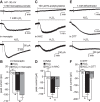Hydrogen Peroxide Gates a Voltage-Dependent Cation Current in Aplysia Neuroendocrine Cells
- PMID: 31676600
- PMCID: PMC6978942
- DOI: 10.1523/JNEUROSCI.1460-19.2019
Hydrogen Peroxide Gates a Voltage-Dependent Cation Current in Aplysia Neuroendocrine Cells
Abstract
Nonselective cation channels promote persistent spiking in many neurons from a diversity of animals. In the hermaphroditic marine-snail, Aplysia californica, synaptic input to the neuroendocrine bag cell neurons triggers various cation channels, causing an ∼30 min afterdischarge of action potentials and the secretion of egg-laying hormone. During the afterdischarge, protein kinase C is also activated, which in turn elevates hydrogen peroxide (H2O2), likely by stimulating nicotinamide adenine dinucleotide phosphate oxidase. The present study investigated whether H2O2 regulates cation channels to drive the afterdischarge. In single, cultured bag cell neurons, H2O2 elicited a prolonged, concentration- and voltage-dependent inward current, associated with an increase in membrane conductance and a reversal potential of ∼+30 mV. Compared with normal saline, the presence of Ca2+-free, Na+-free, or Na+/Ca2+-free extracellular saline, lowered the current amplitude and left-shifted the reversal potential, consistent with a nonselective cationic conductance. Preventing H2O2 reduction with the glutathione peroxidase inhibitor, mercaptosuccinate, enhanced the H2O2-induced current, while boosting glutathione production with its precursor, N-acetylcysteine, or adding the reducing agent, dithiothreitol, lessened the response. Moreover, the current generated by the alkylating agent, N-ethylmaleimide, occluded the effect of H2O2 The H2O2-induced current was inhibited by tetrodotoxin as well as the cation channel blockers, 9-phenanthrol and clotrimazole. In current-clamp, H2O2 stimulated burst firing, but this was attenuated or prevented altogether by the channel blockers. Finally, H2O2 evoked an afterdischarge from whole bag cell neuron clusters recorded ex vivo by sharp-electrode. H2O2 may regulate a cation channel to influence long-term changes in activity and ultimately reproduction.SIGNIFICANCE STATEMENT Hydrogen peroxide (H2O2) is often studied in a pathological context, such as ischemia or inflammation. However, H2O2 also physiologically modulates synaptic transmission and gates certain transient receptor potential channels. That stated, the effect of H2O2 on neuronal excitability remains less well defined. Here, we examine how H2O2 influences Aplysia bag cell neurons, which elicit ovulation by releasing hormones during an afterdischarge. These neuroendocrine cells are uniquely identifiable and amenable to recording as individual cultured neurons or a cluster from the nervous system. In both culture and the cluster, H2O2 evokes prolonged, afterdischarge-like bursting by gating a nonselective voltage-dependent cationic current. Thus, H2O2, which is generated in response to afterdischarge-associated second messengers, may prompt the firing necessary for hormone secretion and procreation.
Keywords: H2O2; bursting; mollusk; peptidergic neuron; redox; reproduction.
Copyright © 2019 the authors.
Figures











References
-
- Arch S, Smock T (1977) Egg-laying behavior in Aplysia californica. Behav Biol 19:45–54. 10.1016/S0091-6773(77)91331-1 - DOI
Publication types
MeSH terms
Substances
Grants and funding
LinkOut - more resources
Full Text Sources
Research Materials
Miscellaneous
